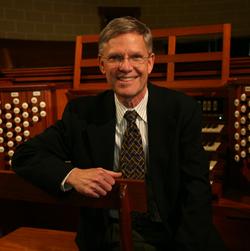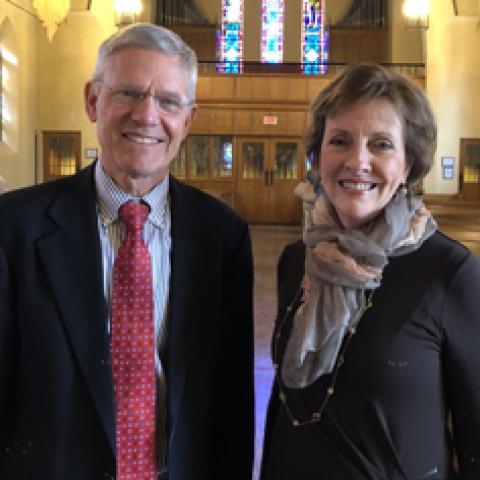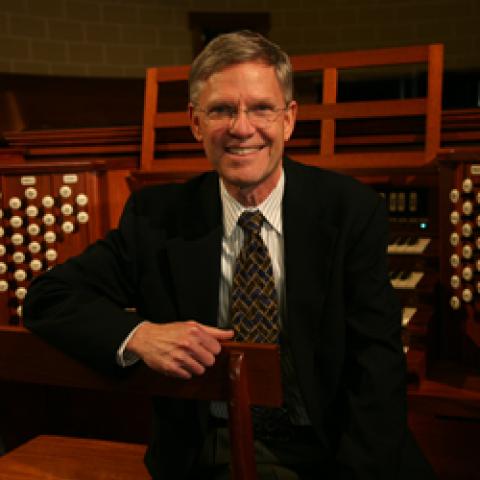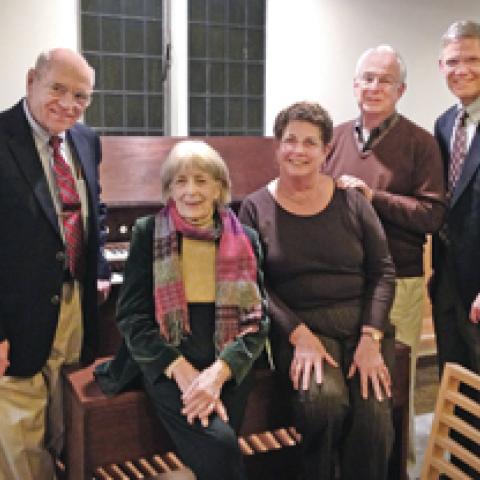James Leslie Boeringer, born March 4, 1930, in Pittsburgh, Pennsylvania, died January 12 of pancreatic cancer. He earned a BA in organ performance from the College of Wooster (Ohio) in 1952, an MA in musicology from Columbia University in 1954, a doctorate in sacred music from the former Union Theological Seminary in New York, New York, in 1964, and completed post-doctoral studies at New York University. Boeringer received associate certification from the American Guild of Organists in 1953. He presented recitals in organ and harpsichord in 20 of the United States, and in England and France.
Beginning with his first church position, as organist of Homewood Baptist Church in Pittsburgh in November 1947, he served churches in Ohio, New Jersey, New York City, South Dakota, Oklahoma, Pennsylvania, North Carolina, and London, England. He moved to the Washington, D.C., area in 1992 and served as organist at Church of the Pilgrims (Presbyterian) Washington, Messiah Lutheran Church in Germantown, and Fifth Church of Christ, Scientist, in Georgetown, playing his last service December 29, 2013, just two weeks before his death.
Boeringer served as executive director of the Moravian Music Foundation in Winston-Salem, North Carolina, as university organist and on the faculty at the University of South Dakota in Vermillion, Oklahoma Baptist University in Shawnee; at Susquehanna University in Selinsgrove, Pennsylvania, he was a professor and chair of the music department. A Phillips Distinguished Visitor at Haverford College, he founded the Krisheim Church Music Conference in Philadelphia, and directed the Creative Arts Festival at Susquehanna University from 1972 to 1975, and the Moravian Music Festival in 1981 and 1984.
As a composer Boeringer wrote 23 published original works for chorus and organ, organ solo, chamber ensemble, and other combinations, including a cantata and a song cycle; and about 50 unpublished pieces, including an oratorio with full orchestra. He wrote more than 25 hymn tunes and hymn texts, some of which appear in Baptist, Lutheran, Mennonite, Moravian, and ecumenical hymnals. Selected works are available through the International Music Score Library Project (IMSLP) website (imslp.org).
He authored the three-volume Organa Britannica: Organs in Great Britain, 1660–1860, as well as other books on hymnody and biographies of organists and composers of church music. His essays were published in periodicals and books.
A widely published arts critic and scholar, he wrote numerous articles and reviews, which appeared in the Journal of Church Music; Moravian Music Journal; Music, the A.G.O. Magazine; The Organ Yearbook (Netherlands); The Musical Times (London); The New York Times; The American Organist; The Diapason; and The Tracker. He was the editor for the Society for Organ History and Preservation.
Boeringer published fiction under a pseudonym. A member of Equity, he has a long list of theater credits in a variety of roles including actor, singer, director, music director, composer, narrator, and chorus arranger. He had an abiding interest in historic buildings and moved and restored two log cabins in his lifetime, and was an avid gardener.
James Leslie Boeringer is survived by his wife of 58 years, Grace, and children Lisa Stocker, Greta, and Daniel, and a brother David.
Peter Rasmussen Hallock died April 27, 2014, in Fall City, Washington; he was 89. A composer, organist, liturgist, and countertenor, among other activities, he was long associated with St. Mark’s Episcopal Cathedral of Seattle. Hallock began organ study with Clayton Johnson of Tacoma. He enrolled at the University of Washington, but was drafted into the United States Army, serving from June 1943 until February 1946 as chaplain’s assistant and sharpshooter in the Pacific theater during World War II. Returning to the University of Washington, he studied organ with Walter Eichinger and composition with George McKay, then studied at the College of St. Nicholas at the Royal School of Church Music (RSCM) in Canterbury, England, becoming the first American choral scholar at Canterbury Cathedral, under the direction of Gerald Knight. He completed the RSCM program and received a bachelor of arts degree in music from the University of Washington in 1951 and master of arts degree in music from the same institution in 1958.
Peter Hallock became organist/choirmaster of St. Mark’s Episcopal Cathedral, Seattle, on October 28, 1951, a position he held until retirement in 1991. At St. Mark’s, he founded a chant study group in the mid 1950s that became known as the Compline Choir, which remains in the forefront of the resurgence of interest in the Office of Compline. He was instrumental in the cathedral’s acquisition of a four-manual Flentrop mechanical-action organ in 1965. At the cathedral, Hallock also introduced Advent and Good Friday processions as well as liturgical drama. He was named Canon Precentor, the first lay person in the Episcopal Church to hold this title, named an associate of the RSCM, and was honored with an honorary doctor of music degree by the Church Divinity School of the Pacific. In 1992, he became organist at St. Clement of Rome Episcopal Church, Seattle, remaining until March 2013. Hallock was also well known and respected for his countertenor concerts, with performances throughout the United States. As a composer, Peter Hallock created more than 250 works, from occasional church music to extended anthems, dramatic works (sacred and secular) to music specifically written for the Compline Choir. Among his many publications was The Ionian Psalter.
Peter Rasmussen Hallock is survived by his sisters, Matilda Ann Milbank of Los Altos, California, and Barbara Hallock of Kent, Washington, as well as several nieces, nephews, grandnieces, and grandnephews. Memorial gifts may be made to the Compline Choir of St. Mark’s Cathedral or to the Cathedral Foundation of the Diocese of Olympia, Seattle.
Robert Burgess Lynn, 83 years old, passed away February 11 in Houston, Texas. A native of Colorado Springs, he studied organ and piano with Roy Harris, Frederick Boothroyd, and Joanna Harris while in high school. In 1952, he earned a BA at Colorado College (where he studied with Frederick Boothroyd and Max Lanner, and was chapel organist), and a master’s in organ from the Juilliard School of Music, received Honorable Mention in the AGO Young Artists’ Contest in Organ Playing in San Francisco, and married Elaine Steele, also a musician. In 1956, Lynn received a Fulbright Scholarship to study organ playing and construction with Finn Viderø under the auspices of the University of Copenhagen. His studies were briefly delayed when the family’s ship, the Stockholm, collided with the Andrea Doria, which subsequently sank. During his time in Copenhagen, he saw and played several great organs, including the organ at Sweden’s Malmö Museum, built in 1520, and at the Royal Chapel in Copenhagen, built in 1827. Lynn became a Fellow of the AGO in 1964, receiving the highest marks of any candidate in Section I of the FAGO examinations.
Robert Lynn taught from 1954 to 1971 at Allegheny College as an assistant professor of music. In 1973, he received his PhD in musicology from Indiana University; his dissertation was entitled “Renaissance Organ Music for the Proper of the Mass in Continental Sources.” From 1971 to 1997, he served as professor of musicology at the University of Houston where he also directed the Collegium Musicum and the graduate studies program. His monograph, Valentin Haussmann (1565/70–Ca. 1614): A Thematic-Documentary Catalogue of His Works, was published by Pendragon Press. In 1997, he was named professor emeritus.
Lynn also enjoyed visiting professorships at Rice University, Indiana University, and the University of Siegen. While a resident of Houston, Lynn was well known for his organ recitals in addition to his role as harpsichord soloist, playing in many concerts associated with the Houston Harpsichord Society (now Houston Early Music). From 1982 to 2004, he was the founding director of the Houston Bach Choir and Orchestra at Christ the King Lutheran Church. Lynn served as director of music and organist at St. Francis Episcopal Church for 25 years, and also as long-term interim organist at St. Christopher’s Episcopal Church. Memorial contributions may be made to the Bach Society Houston, 2353 Rice Blvd, Houston, TX 77005, or to the Christ Church Cathedral Music Program, 1117 Texas Ave., Houston, TX 77002.
Fred S. Mauk died on April 7, two weeks before his 83rd birthday, after a short illness. Mauk did his undergraduate study at Stetson University and Rollins College, where he earned a degree in music, and received his master’s degree in 1958 from the School of Sacred Music at Union Theological Seminary in New York City. He held church music positions in Missouri, South Carolina, North Carolina, and Florida, his last position being director of music for 33 years at St. Mark’s Presbyterian Church in Altamonte Springs, Florida, where he retired in 2011; at St. Mark’s he installed a pipe organ (purchased from a church in North Carolina) in the sanctuary.
An active member of the Central Florida AGO chapter, Mauk served in many chapter positions, including dean, and was instrumental in coordinating the 1993 regional AGO convention in Orlando. He was also known for his encouragement of young musicians, his sense of humor, his organizational skills, his many interests, including old cars and antique car shows, and his ability to work well with everyone.
Mary Lou McCarthy-Artz, age 78, died at her home in Plymouth, Indiana, on May 7. Born November 18, 1935, Mary Lou Smith graduated from high school in 1953, marrying her first husband, Joseph L. Merkel, two years later. She studied piano at the Jordan Conservatory of Music, Butler University, in Indianapolis. After her husband’s death, she married Rodney Evans and moved to Covington, Indiana, where they lived for more than twenty years. It was there, while holding down a full-time job as an executive secretary, that she began working part-time as organist at nearby Catholic parishes: St. Joseph, Covington; St. Bernard, Crawfordsville; and Holy Family, Danville, Illinois. In 1993, she began full-time ministry as organist and choir director for the motherhouse of the Poor Handmaids of Jesus Christ, Ancilla Domini, in Donaldson, Indiana. A long-time member of the American Guild of Organists, she had served as chapter dean and had recently earned her CAGO certificate. Mary Lou McCarthy-Artz is survived by her husband, Donald Artz, two daughters, Nancy Merkel Starkey of Jacksonville, Florida, and Janet Evans Snyder of Georgetown, Illinois, as well as two grandchildren. ν





